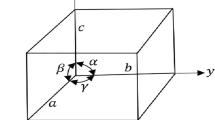Abstract
Large single crystals of PETN, RDX, and TNT can be grown easily from evaporating ethyl acetate solutions. The crystals all share a similar type of defect that may not be commonly recognized. The defect generates conical faces, ideally mosaic crystals, and may account for the “polymorphs” of TNT and detonator grades of PETN.
TATB crystals manufactured by the amination of trichlorotrinitrobenzene in dry toluene entrain two forms of ammonium chloride. One of these forms causes “worm holes” in the TATB crystals that may be the reason for its unusually low failure diameter.
Strained HMX crystals form mechanical twins that can spontaneously revert back to the untwinned form when the straining force is removed. Large strains or temperatures above 100°C lock in the mechanical twins.
Similar content being viewed by others
Author information
Authors and Affiliations
Rights and permissions
About this article
Cite this article
Cady, H.H. Growth and Defects of Explosives Crystals. MRS Online Proceedings Library 296, 243–254 (1992). https://doi.org/10.1557/PROC-296-243
Published:
Issue Date:
DOI: https://doi.org/10.1557/PROC-296-243




